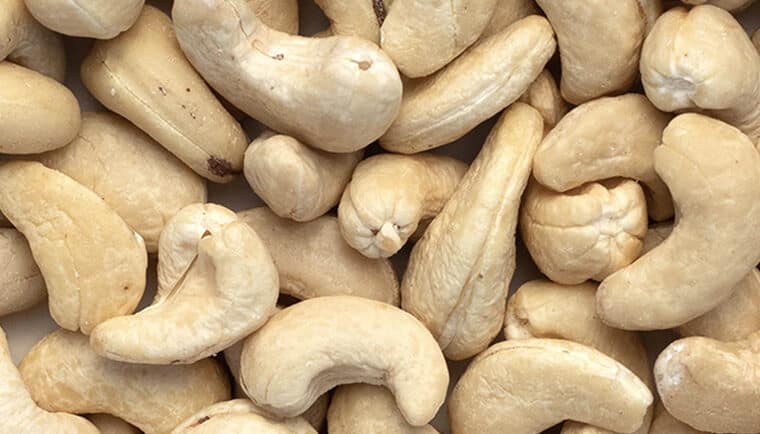
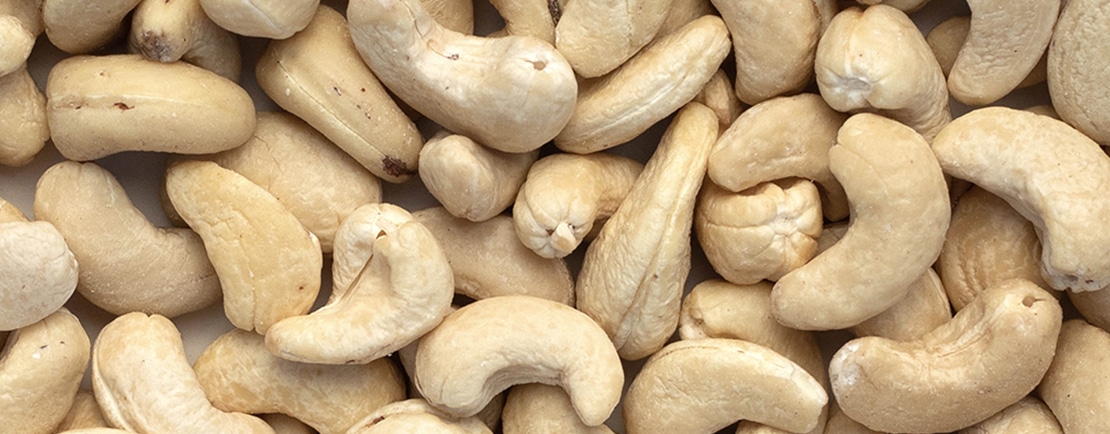


Cashews are very popular with those who live a vegan lifestyle as their creaminess makes them a great dairy substitute and welcome addition to vegan cooking. They are one of our favorite ingredients at Forager Project. Have you ever wondered how cashews grow? How cashew farming impacts the environment? How nutritious are cashews? How cashew-based vegan products compare to other dairy substitutes? How to use cashews in cooking? The following guide attempts to answer all the most pressing questions you may have about cashews.
Cashews are part of the fruit of a tropical tree native to South America. Many people wonder, “are cashews legumes?” The answer is no, despite some characteristics in common, because legumes do not grow on trees and cashews do.
According to LiveScience, cashew trees are native to Brazil. A cashew plant is a tropical plant that is sensitive to the cold and does not do well in temperate regions. However, as long as conditions are otherwise favorable, they can grow in warm climates around the world. While Brazil is still a main producer of cashew nuts, other areas where cashews are grown include:
There is an unexpectedly complex answer to this seemingly straightforward question. According to Healthline, there is a spirited debate surrounding the question of whether cashews should be considered a fruit or a nut, and there is a valid case to be made either way. Everyone agrees that cashews are the seed of the cashew tree. Each is encased in a hard shell, sometimes referred to as a “pod” or “drupe”, that extends from the bottom of a fruit, referred to as a “cashew apple.” Though bitter due to its acidic content and rarely eaten on its own, the cashew apple is edible. If you are wondering about allergy risk with cashews, you have a higher risk of allergy to cashews if you are allergic to other tree nuts or legumes.
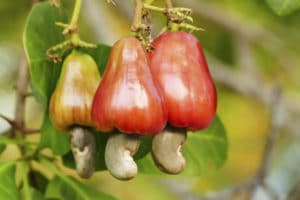
The hard exterior shell of cashews contains an oil called urushiol which can cause blisters or burns so it requires professional handling and careful precautions. For this reason, cashews are not nuts that can be casually shelled and eaten by the consumer. Cashew processing plants may make – use automation for splitting and shelling the cashews to protect the factory workers from exposure to the urushiol.
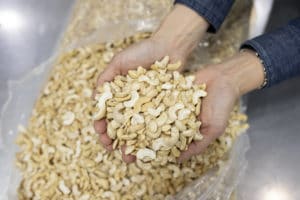
Today, the leading world producer of cashews is Vietnam. Vietnam provides the ideal growing conditions for the cashew plant. Cashew farming has helped Vietnam to recover economically following the Vietnam war, which ended less than 50 years ago. The land used for cashew farming today still bears scars from the conflict, with cashew trees growing in and around craters left by explosives. Another effect the war has had on Vietnamese culture is that it is now customary for women to bear the brunt of the responsibility of earning money to support the family while men stay home to take care of the children.
Organic cashew farms in Vietnam are steadfast in adhering to organic and sustainable farming practices. Organic, fair-trade cashew farming in Vietnam, outside of harvest season, is relatively low maintenance requiring minimal agricultural inputs which makes it an attractive job path for working mothers in Vietnam because it affords them more time with their families. Some women even bring their young children to the orchard with them. The pace is relaxed and the workers chat easily with one another as they sweep the orchard to make it easier to harvest the cashews when they eventually drop. This laid-back feel of farming is reminiscent of grape farms in Sonoma County, California.
Generally, eating any nut is considered healthy as they are whole foods that are minimally processed. There are a number of health benefits of eating cashews in particular.
Cashews have low calorie and sugar content. In addition to being high in antioxidants and fiber, cashews are also high in unsaturated fats, which are considered the “good” fat that the body needs to function. An ounce of cashews provides the following vitamins and minerals in recommended Daily Value percentages:
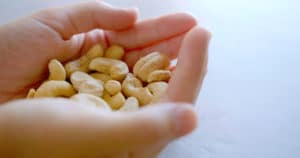
Cashews: Among the many cashew benefits available is its ability to simulate dairy products. Cashews naturally have a smooth, creamy texture that lends itself well to dairy substitutes, including cashew cheese, and cashew yogurt. The cashew also has a light, neutral taste that doesn’t overwhelm the flavor of the other ingredients when used in recipes.
Almond: Almond milk is one of the top plant-based milk alternatives. Like cashews, almonds also have a neutral taste, making them a good dairy substitute in terms of flavor.
Oat: Oatmilk naturally has a slightly sweeter taste than cashewmilk. Oatmilk pairs particularly well with coffee due to its thick and creamy texture and ability to foam.
Coconut: Coconut is used across a wide variety of vegan products, such as vegan cheese, vegan yogurt, vegan butter, vegan ice cream and more. While coconut has a creamy texture that mimics dairy, it is important to keep in mind that coconut has a much stronger flavor than other dairy substitutes and is therefore not a neutral base.
Many people who adopt a vegan lifestyle do so out of concern for the negative impact that animal products have on the environment. Generally, plant-based milk substitutes are better for the environment than dairy milk given the significant amount of resources animal farming requires. However, when it comes to choosing plant-based dairy substitutes, it is important to consider the ecological impacts and benefits of cashews vs. almonds vs. oats.
Cashews: Cashew trees are fairly drought resistant. When grown in wet areas, like Vietnam, they do not require irrigation as they receive enough moisture from the rainfall. Cashews are ideal for organic farming because their strong defenses make them naturally resistant to pests (i.e. no need for insecticides). Cashews neutral taste and creamy texture
Oatmilk: Oatmilk has become one of the most popular vegan milks very quickly. Oats have similar land requirements to other plant-based milk bases, but oats require less water than almonds. It is important to buy organic oats and oat products to avoid consuming high levels of glyphosate, an herbicide used in conventional oat farming.
Almond milk: Almond milk has also received a lot of attention as a plant-based dairy substitute, however almond milk is resource intensive. Almond trees need large amounts of water to grow. Growing a single almond takes about a gallon of water, meaning that sustaining a single almond tree can require hundreds of gallons. Ninety percent of the world’s supply of almonds comes from California, an arid region that does not see much rainfall and has been in a drought for much of the last decade. In order to grow almonds in California, water must be taken from reservoirs (water held in reserve for the state)
Rice milk and soy milk are other popular plant-derived dairy alternatives that are better for the environment than dairy milk or almond milk.

Cashews are versatile enough to use in a number of vegan recipes, from beverages to entrees to desserts.
One tasty way to eat cashews is to roast them in the oven with salt and desired spices. To roast cashews, heat the oven to 350 degrees and roast them for approximately 10 minutes – turning them halfway through to prevent any burning.
Blend 3 cups of roasted or unroasted cashews in a food processor. Blend until creamy, adding 2 tablespoons of coconut oil for a thinner nut butter. Add salt, sugar, or desired spices once the desired consistency is achieved.
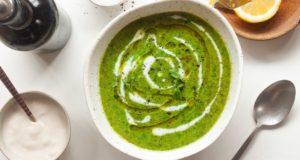
Cashew cream or cashew milk are common ingredients in soups, such as this Herby Green Goddess Soup.

Roasted cashews also add a nice crunch to salads or curry dishes, as shown in this Coconut Cauliflower Curry.

Cashews creamy textures makes them the perfect base for creamy pasta sauces, like this Vegan Baked Mac and Cheese.

Cashew milk and sour cream are key ingredients in many vegan desserts, such as this Vegan Lemon Tart, which uses both.
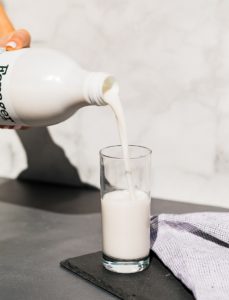
Forager Project Cashewmilk is made from cashews farmed sustainably and sourced ethically in Vietnam and produced at our small facility in Indio, California. Forager Project Cashewmilk is a convenient alternative to making your own cashewmilk. If you are eager to make your own cashew milk, try this DIY recipe:
Feel free to play around with the proportions to create a milk as creamy or as sweet as you’d like. To make it creamier, add more cashews for a sweeter milk, add a touch of maple syrup, coconut sugar or lucuma fruit powder. For a spiced cashew milk, try adding nutmeg, cinnamon and cardamom. Soaking the cashews ahead of time and having a powerful blender helps the cashews break down better, ultimately creating a smoother milk.
Ingredients
2 1/2 cups filtered water
1/3 cup unsalted cashews
1 tablespoon coconut sugar, or sweetener of your choice
Pinch of sea salt
Prep
Boil a 1- 2 cups of water and pour it over the cashews. Let the cashews sit and soften for at least 5 minutes. Drain the cashews. Using a high-speed blender, blend the cashews and 2 1/2 cups of fresh filtered water. Add the salt and if you want, the coconut sugar (or sweetener of your choice). Let the blender run on high speed for 5 minutes or until you can’t see any cashew bits. Strain the mixture through a fine sieve and pour milk into a clean container. Refrigerate and let cool – this cashew milk tastes best the day after it has been made, once it has fully cooled and it typically stays fresh for 5 days.

Forager Project is a family-owned and operated organic food company, crafting plant-based foods in California since 2013.